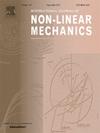考虑衬砌开裂的透水混凝土衬砌水-力相互作用
IF 2.8
3区 工程技术
Q2 MECHANICS
International Journal of Non-Linear Mechanics
Pub Date : 2025-02-11
DOI:10.1016/j.ijnonlinmec.2025.105044
引用次数: 0
摘要
混凝土衬砌在高压引水隧洞中起着至关重要的作用,准确预测混凝土衬砌的开裂和渗漏行为对有效的工程设计至关重要。然而,由于工作环境和荷载条件的复杂性,衬砌开裂和渗漏的影响规律尚不完全全面,设计方法有待改进。本文旨在加深对承压隧道透水混凝土衬砌水-力相互作用的认识。它将隧道概念化为由混凝土衬砌、注浆环和围岩组成的结构。基于位移连续性和流动连续性原则,建立了考虑内外水压的解析模型。通过与已有解析解、物理模型实验和工程监测数据的对比,验证了所建模型的正确性。该模型综合考虑了衬砌-围岩结构和衬砌-注浆环-围岩结构的内外水界条件,拓宽了其适用范围。采用控制变量法,利用钢筋应力、裂缝宽度、渗漏量等指标,分析混凝土等级、配筋率、衬砌厚度、围岩弹性模量、围岩渗透系数、注浆环厚度、注浆环渗透系数等因素对衬砌开裂和渗漏的影响。最后,提出了一种透水混凝土衬砌优化设计方法,并通过实例验证了该方法在工程实践中的适用性。该研究对提高高压隧道混凝土衬砌的可靠性和性能具有重要意义。本文章由计算机程序翻译,如有差异,请以英文原文为准。
Hydraulic-mechanical interaction of pervious concrete lining considering lining cracking in pressure tunnels
Concrete lining plays key role in high-pressure water diversion tunnels, where accurately predicting their cracking and leakage behavior is essential for effective engineering design. However, due to the complexity of the working environment and load conditions, the influencing patterns of lining cracking and leakage remains not fully comprehensive and the design methods need improvement. This paper aims to contribute to deepen the understanding of hydraulic-mechanical interaction of pervious concrete lining in pressure tunnels. It conceptualizes the tunnel as a structure comprising concrete lining, grouting ring, and surrounding rock. An analytical model is developed based on principles of displacement continuity and flow continuity, considering both internal and external water pressures. By comparing with existing analytical solution, physical model experiment, and engineering monitoring data, the correctness of the established model was verified. This model comprehensively considers internal and external water boundary conditions for both the lining-surrounding rock structure and the lining-grouting ring-surrounding rock structure, thereby broadening its applicable scenarios. Using the control variable method, the study analyzes the influence of factors such as concrete grade, reinforcement ratio, lining thickness, elastic modulus of surrounding rock, permeability coefficient of surrounding rock, grouting ring thickness and permeability coefficient of grouting ring on lining cracking and leakage, using indicators like steel stress, crack width, and leakage. Finally, the study proposes an optimization design methodology for pervious concrete lining, supported by illustrative examples that demonstrate its applicability in engineering practice. This research contributes valuable insights into enhancing the reliability and performance of concrete lining in high-pressure tunnels.
求助全文
通过发布文献求助,成功后即可免费获取论文全文。
去求助
来源期刊
CiteScore
5.50
自引率
9.40%
发文量
192
审稿时长
67 days
期刊介绍:
The International Journal of Non-Linear Mechanics provides a specific medium for dissemination of high-quality research results in the various areas of theoretical, applied, and experimental mechanics of solids, fluids, structures, and systems where the phenomena are inherently non-linear.
The journal brings together original results in non-linear problems in elasticity, plasticity, dynamics, vibrations, wave-propagation, rheology, fluid-structure interaction systems, stability, biomechanics, micro- and nano-structures, materials, metamaterials, and in other diverse areas.
Papers may be analytical, computational or experimental in nature. Treatments of non-linear differential equations wherein solutions and properties of solutions are emphasized but physical aspects are not adequately relevant, will not be considered for possible publication. Both deterministic and stochastic approaches are fostered. Contributions pertaining to both established and emerging fields are encouraged.

 求助内容:
求助内容: 应助结果提醒方式:
应助结果提醒方式:


